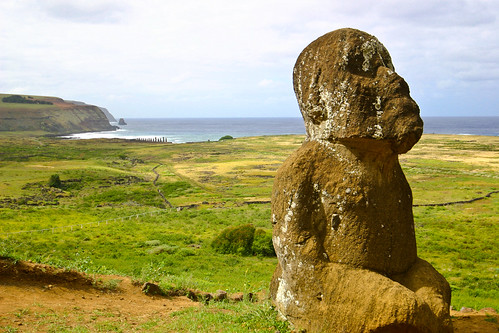Honeymoon in Fantasy Honeymoon Islands

Image : http://www.flickr.com
Remember Mr. Roarke and Tattoo from the 70's hit show Fantasy Island? Honeymoon guests and people of all walks of life were invited to the private island to experience their fantasies and dreams, sometimes to bitter ends. Which mysterious island were they on exactly? The leis and hula dances might hint at any of the Polynesian islands of the South Pacific.
Obviously, Polynesian (which literally means "many islands") culture is more than flowers leis, grass skirts and pineapple punches. This is a group of peoples who have migrated onto more than a thousand island landforms in the South Pacific over a thousand years ago. Sadly, today there are only a few independent island nations left. With customs and traditions thriving to this day, the Polynesian people are fiercely proud of and promote a recent resurgence of their culture, and strive to educate travelers on the importance of preserving their way of life.
The Polynesian Islands are a chain of islands each with distinct personalities but sharing a common heritage. More and more, responsible honeymoon vacationers are skipping on Hawaii and New Zealand for the lesser-known Polynesian islands in respect of the language, the land and the people of these islands.
A Bit of History...
The Polynesian people are a group of Austronesian and Malay ancestors who migrated to these South Pacific islands from the east (Fiji, Samoa) to the west (Rapa Nui) as far back as 300 B.C. The Polynesian Islands cover a triangular shaped area in the South Pacific Ocean with Hawaii at its northern apex, Aotearoa (New Zealand) at the West, and Rapa Nui (Easter Island) on the East. Most of the islands were explored and colonized by the French, the Spanish, and the British over a thousand years ago, and more recently the U.S. Today, Samoa, Tonga and Tuvalu survive as only a few of the fully independent nations. Some of the islands though have been given complete autonomy over their culture and infrastructure development, as have Hawaii and Fiji in the last several decades. Hawaii has gone to great lengths to develop the Polynesian Cultural Centre to educate visitors on the many different islands and over 30 different Polynesian groups living within (or near) the Polynesian triangle today.
Fantasy Honeymoon Islands...
Fiji
The Fijians are a friendly people, but historically, their neighboring Polynesians feared them, as they were fierce cannibals of grand stature. This aspect of their culture has obviously faded but their food, language and customs live on. Fiji is a popular diving and snorkeling destination. Families and honeymooners travel to this island each year to enjoy the fresh fruit, world-class resorts, and pristine beaches. Because of the island's close proximity to Aotearoa, or New Zealand, honeymooners will not only share in typical Polynesian luaus and seafood, but also dine on scrumptious New Zealand beef. Half of Fiji's population is also East Indian, so guests will delight in the traditional Indian dishes widely available.
Samoa
Samoa is an independent nation of the Polynesian Triangle. It is less crowded than Fiji or Hawaii, and honeymoon travelers enjoy the seclusion of the island. If you are looking for an island off the beaten track, this is the country for you. In addition to the gorgeous tropical landscape, you can experience one of the more ancient Polynesian cultural experiences with the Fa'a Samoa, which means "the Samoan way of life." The Fa'a Samoa include nights of Fia Fia dancing and singing as well as the original form of fire- dancing.
Tonga
Tonga is also an independent nation. It is probably the best success story of Polynesian independence. The people of this island nation are beautiful physically and characteristically and intelligence is highly valued. Almost 100 % of the population is literate. The resorts are more rustic than other islands, but the experiences are unforgettable. The islands of Vava'u are unique in their underwater sports locations but also in the chance for honeymooners to swim with the whales. If you go on your honeymoon to this magical group of islands you will be sure to fulfill all your tropical island fantasies. Be careful though - public displays of affection are frowned upon and modesty is required.
Rapa Nui
Rapa Nui has faced more than a few conflicts (albeit peaceful ones) in its strive for autonomy. The island is an overseas territory of the South American country of Chile. Over the last several decades, Rapa Nui has been facing two important battles - their need for autonomic governance and the preservation of the ecosystem. Famous for their Moai, or large stone statures, its sandy beaches and volcanic mountains, many tourists have flocked to this remotest of inhabited islands to experience the spirituality and mystery of the island. As Rapa Nui's economy is largely dependent on this tourism industry, the country has made recent efforts and appeals to the Chilean government to practice eco-tourism and incorporate sustainable tourism practices.
As Honeymooners with a Conscience...
There are over 40 island nations in the Polynesian Triangle and over a thousand landforms with delicate ecological structures. In addition, the Polynesian peoples of these various nations are continually striving to preserve their way of life while joining in the global market. Do your part to help out these communities that offer so much to honeymooners and travelers alike by educating yourselves on how you can help. For more information, visit some of these following websites.
Fiji aid: http://www.fijiaidinternational.com
Polynesian Cultural Centre: http://www.polynesia.com
Discover honeymoon stories, tips and more articles at http://www.myhoneymoonstory.com
0 comments:
Post a Comment